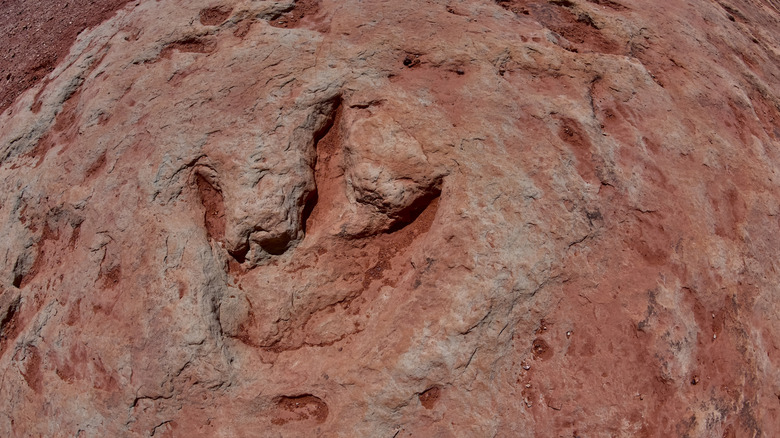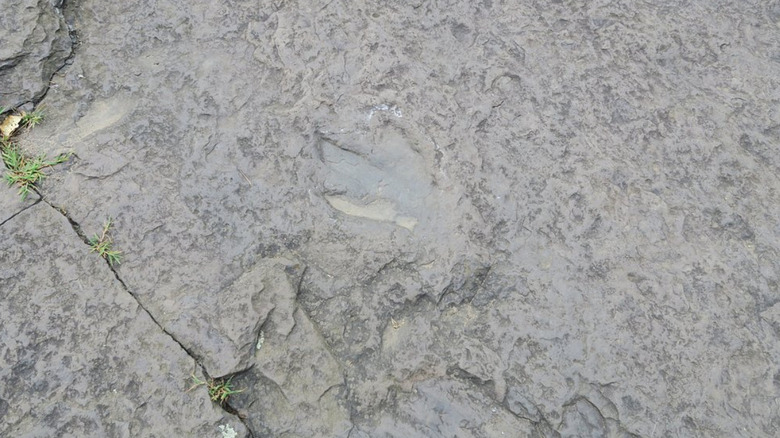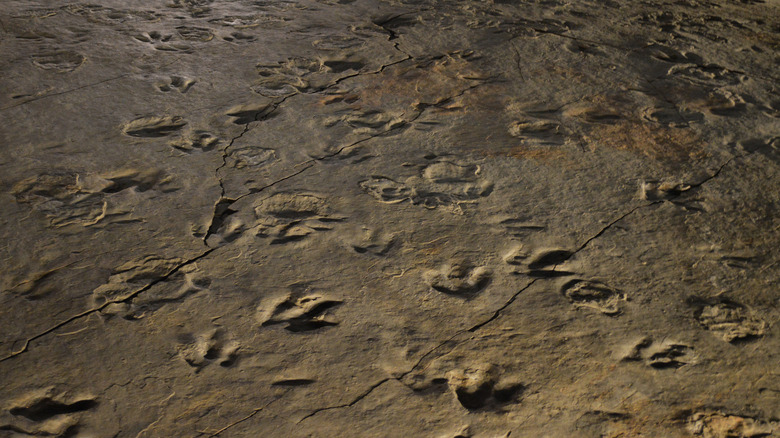Hike In Prehistoric Dinosaur Footprints At This Unique Massachusetts Attraction
You don't have to buy a ticket to Jurassic Park to walk amongst the dinosaurs — well at least to walk among dinosaur tracks. There's a unique nature reservation in Western Massachusetts where hikers can traverse the wooded trails of New England while following the same forested thoroughfares of early Mesozoic animals, and yes that includes some impressive dinosaurs. Located a quick 12-mile drive from the Massachusetts city of Springfield, the Pioneer Valley Dinosaur Footprints are now a part of a reserve stewarded by the Trustees of Reservations, a history and nature non-profit that conserves historic architecture and ecological reservations for public enjoyment.
Discovered in 1802, these fossils chronicle the activity of dinosaurs in the area when the Connecticut River Valley was once a series of shallow lakes and subtropical wetlands around 200 million years ago. Today, the Pioneer Valley, an area that encompasses part of the larger Connecticut River Valley, is a breathtaking Massachusetts region brimming with charming towns. Given the Berkshire Mountains and valley, it is one of New England's most iconic destinations with leafy views during the fall and historic charm, year-round. But the area's history begins far before human settlement, and the Dinosaur Footprints is a reminder of life during a time when the ecosystem looked very different.
How to visit the Dinosaur Tracks
Located off of Route 5 in the town limits of Holyoke, Massachusetts, the tracks are nestled among a scenic trail running along Route 5. With a small turnout parking lot and reachable via public transport (the BLUE 48 Bus to/from Northampton/Veterans Park and Connection to Holyoke Mall), the tracks are easily accessible for beginning hikers and casual nature lovers. From the trailhead, visitors will walk down a 100-yard pathway to find the main set of dinosaur footprints. This area has plenty of interpretive signage that details the history of the region and how the dinosaur fossils were formed. Beyond the primary set of prints highlighted, visitors will also find a smattering of dinosaur tracks all along the trail if you keep an eye out for additional fossils that may not be so well-signed.
Seeing the fossils can be a very quick trip, making it a fun, unique stop to break up a long car journey. While the reservation is only open seasonally from April to November due to icing hazards in the winter, it's always free of charge to enter the trails when it's open to the public. During their season, visitors are welcome to explore the trails and prints from sunrise to sunset. But do note that during the colder months, and particularly during times of precipitation, the hike can get muddy or slippery and there may be trip hazards. And of course, when visiting, be respectful of the footprints and the area around you — while you are permitted to touch the prints, please do so gently, and remember to take any trash with you when you exit.
A quick history of dinosaurs in New England and where to find more tracks
New England's Connecticut River Valley was once teeming with dinosaur life; during the Late Triassic and Early Jurassic periods, the region was actually located much closer to the equator than it is today, exhibiting a subtropical atmosphere. Though finding dinosaur bones from that era and before is quite rare, fossilized footprints throughout the valley illustrate a variety of ancient life forms. Therapods, bipedal carnivorous predators like Eubrontes, ruled the roost while smaller bird-like pibedal herbivores lived in the same ecosystems, all habitable due to the tropical wetlands biome. The Pioneer Valley Dinosaur Footprints represent four particular dinosaurs, as well as fossils from alligator predecessors, plants, fish, and stromatolites. These prints distinctly indicate that these dinosaurs often moved in packs as represented by the dozen or more sets of tracks frozen in time on sandstone slabs.
The Pioneer Valley Dinosaur Footprints represent just a small subset of preserved fossilized tracks in New England. Dinosaur State Park in Rocky Hill, Connecticut, for instance, preserves over 750 Dinosaur tracks from the Jurassic period and offers extensive museum exhibits and programming about the region's dinosaur activity. Other areas of the U.S. also boast a quantity of dinosaur tracks; visitors can explore the largest known dinosaur track site in America on the Picketwire Canyon Trail in Colorado to view the over 1,400 tracks in the area. All of these spots, though, will take you back in time to walk in the dinosaur's shoes ... well prints!


